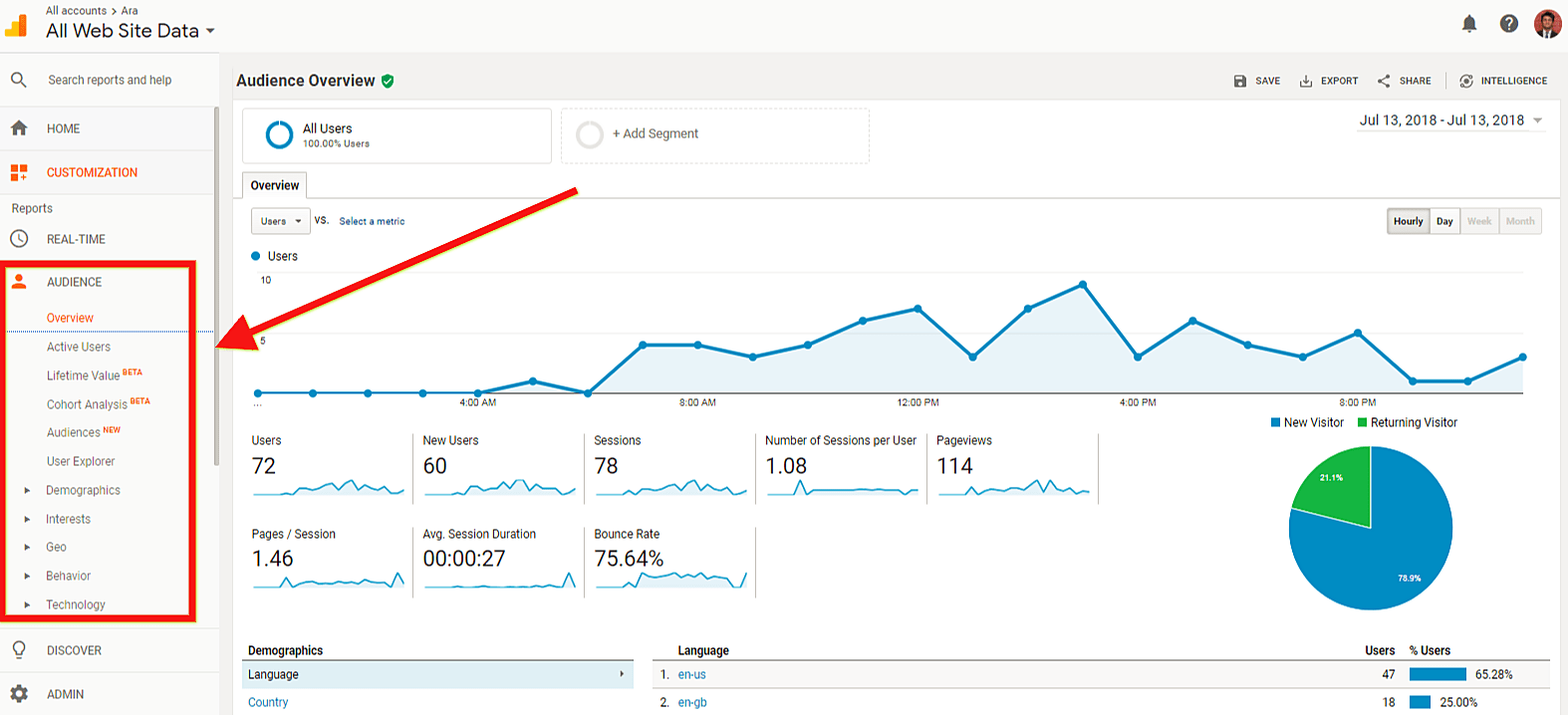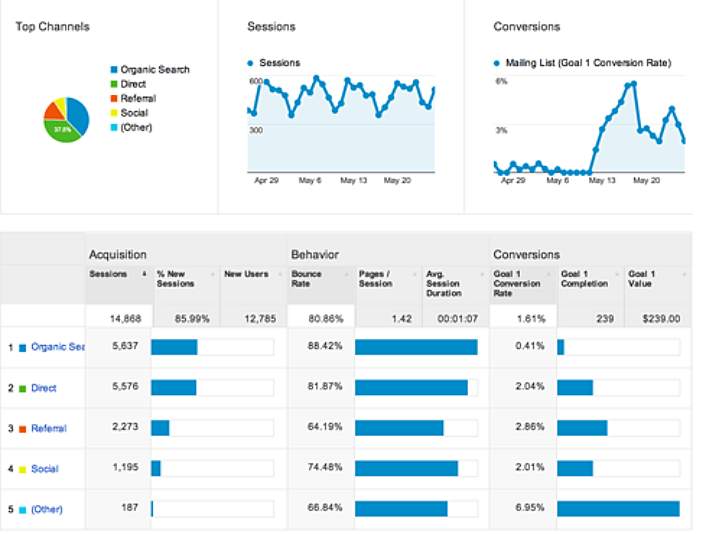Channel Eye joins forces with Jo Buchanan, the Founder of TwitTwooYou, a business growth strategic consultancy centred on getting brands noticed.
The series will give real-world, practical marketing advice. In the first article of the series, Jo focuses on how Google Analytics can really help you and your business.
If you’ve got a website, you’ll want to know how well it is performing. Equally, if you are running a digital marketing campaign, you’ll want to know how well it is performing.
Google Analytics is an amazing tool that offers you insights into what visitors are doing on your website and how well your digital marketing campaigns are performing.
If you don’t yet have a Google Analytics account linked to your website, creating one is super easy to do. All you need to do, to track all the good stuff happening on your site, is to add a little code to your website. Google offers an easy set-up wizard to help you to install the code.
But what can Google Analytics tell me?
Google Analytics can display a multitude of data. Yes, it can sometimes feel a little overwhelming on how to navigate all the charts and tables, but this article will help show you how to captain your data to better effect.
Know your visitors
So you’ve got a client database and maybe you’re lucky enough to own a CRM system (Client Relationship Management) which tells you how many customers you have, where they are from, what they do, and even what their dog is called. But how well do you know who is visiting your website?
Click on Audience and it tells you how many visitors have visited your site over a date range. The Active Users section even tells you how many visitors are on your website right now. Drawdown into Audience and you can find out how many visitors visited your site over a date range, from which location and their possible demographic.

But why does this data matter?
Let’s say you had launched a Facebook or Google Ads campaign targeting the US for two weeks. You go to Google Analytics to check the success of your campaign and your Audience doesn’t show a peak in visits to your website from the US. That is really important as it tells you that the campaign tanked, or you need to review it.
Find out where your web traffic is coming from
So you know you are getting hits from a lot of folk in South Africa and that’s great, but is that all organic searches or maybe that traffic is coming from other channels i.e. social, email, referral? Click on Acquisition and Google Analytics tells you how well each channel is driving visits to your site.

Organic – refers to visitors who found your site using keywords. Unfortunately, Google has stopped displaying the keywords visitors are using to find your website. They say this is all to do with protecting the privacy of the searcher.
Paid Search – This refers to visitors who have arrived on your website from a Google Adwords or other paid search ads that you have placed on specific keywords.
Direct – Relates to visitors who type in your company name to Google to locate your website.
Referral – Visitors who find your website by clicking on a link located on another website. It’s a good idea to try and get your website URL to feature on other websites. Maybe you have partners you work with? Why not add your logo with an embedded link to websites that supply services to you? Alternatively, why not start blogging and add links to your blog page or bio on your website. It all helps.
To get better granularity on your referral and social link data, you can visit your Admin and edit/add names to the defaults on offer to give you even better insight into where the traffic is coming from.
Social – Whether you run adverts on Twitter, Facebook, Instagram or LinkedIn, any traffic that comes from an Ad or post directed to your website, will display as a visit from a ‘social’ channel.
Other – Now this metric is a goodie, it’s the one that picks up (if you’ve created campaign links) all the inbound traffic to your website, driven from email campaigns and the like.
To make sure you are tracking your campaign activity, you should ensure you add a campaign URL to every campaign, using Google’s campaign link tool; URL builder
I’ll be writing an article exclusively in the coming weeks about this tool, so keep a lookout for it.
What’s hot right now; find your most popular pages
Hygiene content is the main content you have on your website i.e. products, services etc. Click on Behaviour and it will tell you which of your pages are proving most popular on your website.
Let’s say you were running a multi-channel digital marketing campaign (think email, Facebook ad, Google Adword) and all links redirected to a campaign landing page on your website. The page isn’t indexed (so not found on your site navigation) and can only be located if you engage with the campaign.
The ‘Behaviour’ section on Google Analytics allows you to see how well campaigns like these might be doing. If you’ve planned your campaign well, your Google Analytics report should show some decent traffic to your landing page and it may even show up as one of your top-performing pages.
Use Google’s URL Builder and compare your page visits by channel sources to identify which elements within your multi-channel campaign performed the best.
Google Analytics can even track lead conversions and sales
If you are an eCommerce brand, chances are you want to track your sales. If you hang out in the B2B world, you’ll want to measure your success through lead generation. Google Analytics can track all of these and more, through a little thing called goals.
It’s all about the goals…
You tell Google Analytics what you want it to track on your website and it will do just that. Say you want to find out how many visitors visit a particular page and play a video, Google Analytics can track that. Maybe you want to track how many visitors download a white paper, Google Analytics can do that too. It can even track how many visitors will complete a contact form or make a sale.
What about Google Analytics 4?
Google Analytics recently gave birth to a new baby, Google Analytics 4, the next generation in web analytics. It promises to provide different kinds of reports from those delivered by the current Google Analytics.
Having sampled it on my own website, it’s still in the very early stages, so don’t yet rely on this new version yet, as the data is still a little sketchy.
Instead, why not add the Google Analytics 4 code to your website now (using the easy set-up wizard Google provides) beneath the current Google Analytics code that’s (hopefully) already hosted on your site. It’ll mean, that when we are invited to move fully to Google Analytics 4, you’ll have lots of rich, historic data from which to peruse.
Google Analytics is more than just graphs and stats, it’s your strategic marketing decision maker’s best friend!
In summary, Google Analytics is a digital marketers best friend as it gives you the data to truly measure the effectiveness of your digital marketing activity. It allows you to track what is truly important in your business and see how small iterations in marketing activity can help you achieve your overall business objectives, be that sales, lead conversion, brand awareness, loyalty and so much more.
This is a sponsored article.

















